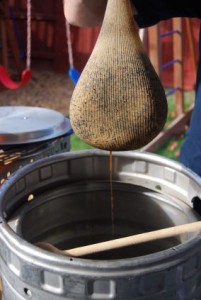 Note: This is a guest post from Tom Holmes.
Note: This is a guest post from Tom Holmes.
Home brewing alcohol was popular among the Chinese, Egyptians and Mesopotamians. These recipes they had were eventually shared with the Greeks and Romans. It was the Sumerians, however, that first wrote these recipes and instructions down. They would also sing a recipe to the beer goddess Ninkasi because very few Sumerians actually read and write.
From Ancient Times To The Americas’ Past
Nothing stays the same in any civilization; some civilizations will rise in power while others are killed off or assimilated. With these changes in civilizations, there are also changes in laws. For instance, one of the first things the Pilgrims did after they landed at Plymouth Rock was build a brewery so that when their alcohol supply got low, they could easily make more.
Any beverages that contained alcohol were not put into mass production until the age of the Industrial Revolution, which took place in the 1700s. Hydrometers and thermometers were created and these aided in the home brewery process. These tools were considered efficient and reliable, which helped brewers make quality alcoholic drinks.
Home brewers started a whole new chapter on brewing thanks to French microbiologist Louis Pasteur who explained how yeast influences the fermentation procedure while being brewed. Brewers then started coming up with varying strains of yeast that would actually yield beers and wines in the complexities they wanted.
It seemed all was going well but again, times change. The United States passed the Prohibition Act that made it illegal to home brew and drink alcohol. Here’s the catch though: it didn’t do much good as people still made their alcoholic drinks and drank them. Since nobody could purchase alcohol in public, home brewers came up with Moonshine and Bathtub Gin to cover the cravings.
It wasn’t just the home brewers who were cashing in; grape growers were also getting in on the action, as the need for grape juice became evident. Thus, grape growers acquired 700 percent more fields to keep up with the growing demand. When shipping grapes off to their buyers, grape suppliers would provide a warning label telling them how they could make wine using creative advertising.
The act was eventually repealed in 1933 but there was just one problem; it didn’t legalize everything for home breweries… just wine. This meant that home brewing beer was still illegal. That is, it was illegal until 1979, when then-president Jimmy Carter signed a bill lifting the regulation. However, state legislators are allowed to decide if they’ll ban home breweries.
Currently, only two states ban the practice:
- Mississippi
- Alabama
Editor’s Note: The following is a guest post by Tom Holmes, publisher of HomeBarReviews.com and former bar/restaurant owner. Tom first became interested in beer and wine-making a few years ago when his children gave him a wine-making kit for a Christmas present. Ever since, Holmes has looked for up to date bar designs and trends and stays current with the latest news and information in beer and wine-making.
Today, he uses this knowledge in conjunction with his knowledge for home bar furniture and equipment to share with others. So if you’re ready to do some home brewing of your own and want a bar for the home, check out his website HomeBarReviews.com to see what he has to offer.
